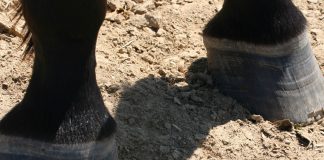
If your horse cannot avoid living in damp footing during the wintertime, he may be prone to thrush and abscesses in his feet. The thrush is due to the constant moisture combined with frequent contact with manure. Abscesses result because the sole of the hoof becomes soft thanks to the exposure to moisture. A step on a sharp stone or a tiny piece of gravel that works its way into a small crack in the sole or hoof wall can result in a painful abscess.
Make sure you clean out your horse’s feet daily. If necessary, after using the hoofpick, use a stiff body brush to sweep away any remaining debris. Next, add a hoof hardener to the soles, avoiding the frog. Thrush remedies, however, can be applied to the frog, particularly to the cleft of the frog and the comasure areas (valleys on either side of the frog) where thrush likes to reside. If you have any questions regarding your horse’s hoof care during the wet winter weather, be sure to consult with your farrier and your veterinarian.
Further Reading
Mud-Related Health Problems







helpful article
This was a great article!
Super article. My horse just got over a thrush infection, and I was so woried. Very good article.
my horse has never had thrush or any other hoof problem probably because she isn’t trapped in a stall all day!
One of my horses picked up thrush in one hoof, and it was the driest summer on record. I do think that this time it came from the farrier tools.
love the article, ithink my horse has thrush but my dad won’t liten to me